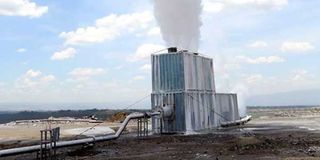Geothermal energy powering future

Geothermal Development Company plant in Menengai, Nakuru County. Geothermal energy is a prolific resource that is exciting researchers to seek fresh approaches to national development. FILE PHOTO | NATION MEDIA GROUP
What you need to know:
The Menengai Geothermal Project is actualising this model.
GDC is also developing other fields such as Baringo-Silali Geothermal Block.
Greenhouses and fishponds will be the next frontier in utilising geothermal for food security.
The national focus in the next five years will be manufacturing, and the provision of affordable housing and health services and enhancing food security. The development of geothermal energy will plug in vital support.
Geothermal energy will be critical, especially in bolstering the twin pillars of manufacturing and food security.
For manufacturing, we need affordable, reliable and clean energy. The sector will be attractive in a regime of friendly tariffs. And nothing promises a spectacular combination of affordability and reliability like the geothermal source.
Indeed, with a geothermal largesse potential of about 10,000MW, this resource will be a game changer in powering the manufacturing sector. It is through geothermal power that the government’s policy of subsidised power to bulk users will be sustained.
DEVELOP RESOURCES
As a special purpose vehicle, the Geothermal Development Company is designed to accelerate the development of geothermal resources.
We will open up green fields mostly dreaded by the private sector, and turn them into bankable projects attractive to investors.
The Menengai Geothermal Project is actualising this model.
In the first quarter of this year, independent power producers (IPPs) will build plants for 105 MW. The Menengai power will be a great relief to manufacturers, who will enjoy cheaper electricity.
GDC is also developing other fields such as Baringo-Silali Geothermal Block.
1,000 MEGAWATTS
Our target is to produce more than 1,000MW in the next 10 years.
Besides electricity, geothermal energy provides direct heat to industrialists. This is a by-product of electricity in the form of steam coming from power plants at about 1500C. As a by-product, it is very cheap, yet, highly sought-after.
There is a robust industry called direct uses that makes sense of the massive heat found in geothermal fluids after power generation. And the heat has many uses.
The heat is also used in the industrial drying of grains, fish, vegetables, tea, and pyrethrum, milk pasteurisation and brewing. The geothermal fluid boosts tourist paradise in form of medicinal spas. The list is endless.
In Nevada, United States, onion and garlic are dried using geothermal heat. In New Zealand, they use geothermal power in paper manufacturing and seasoning timber. In Menengai, we have experimented with the use of geothermal energy for milk pasteurisation, aquaculture, greenhouse heating and in a laundromat.
In milk pasteurisation, manufacturers can cut up to 70 per cent of their heating costs by using geothermal energy. Other studies show that when it is used to heat greenhouses, the cost of production drops by about 40 per cent.
That is why we are excited that with more focus on the development of geothermal energy, Kenya is going to be very competitive in Africa as an investment destination. We are encouraging manufacturers to take advantage of this resource and our expertise.
GDC will support the rise of industrial parks along the geothermal belt that runs from Lake Magadi to Lake Turkana. We also have spots in Homa Hills and Mwananyamala in Kwale.
ATTRACTION
Industrial parks have prospered elsewhere.
In Iceland, the Reykjanes Geothermal Resource Park for fish farming is a huge success. Svartengi Resource Park hosts assorted industries. They range from the extraction of sulphur and silica to carbon dioxide. It also hosts the world-famous Blue Lagoon, a geothermal heated lake that is a five-star attraction for tourists. The beauty of geothermal belts is that manufacturers enjoy bulk uninterrupted power at a bargain with hot steam available almost for a song.
GREENHOUSES
Geothermal power is used to heat greenhouses to accelerate growth of horticultural products, including vegetables. Crops under geothermal-heated greenhouses are pesticide-free because the heat prevents fungi growth. It is also used to heat fishponds.
Our research in Menengai has found that fish grow faster by a third after the pond is heated.
Greenhouses and fishponds will be the next frontier in utilising geothermal for food security.
Geothermal energy is a prolific resource that is exciting researchers to seek fresh approaches to national development.
Our grand dream is to turn geothermal belts into manufacturing and food production hubs. This will create jobs, tame rural-urban migration, and generally improve our fortunes as a nation.
Mr Nchoe is the managing director of Geothermal Development Company. [email protected]





